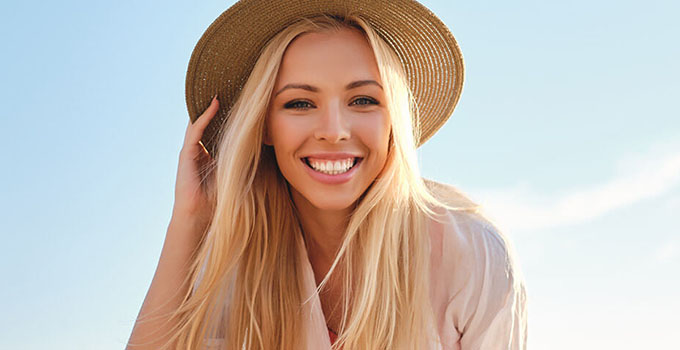New! Face Sunscreen SPF 50 with 15% introductory discount.

Bleaching your hair without damage
Unfortunately, it is not possible to bleach your hair without damaging it. But sometimes you really want a lighter hair colour. We understand that all too well at WECOLOUR. And hair dye, which is usually much gentler on your hair, is not always an alternative to bleach. In fact, hair dye does allow you to dye your hair slightly lighter, but this can only be done on un-dyed hair that is not too dark. So if your hair is dyed and/or very dark in colour, you have to resort to bleaching. Your hair is then bleached because bleaching dissolves the colour pigment in your hair. Unfortunately, bleaching affects not only the colour pigment but also the quality of your hair. Although you cannot prevent it, we have some tips for you that will help you minimize the damage.
How does bleaching your hair work?
Bleach removes the colour pigments from your hair. The active ingredient is hydrogen peroxide, which is also called oxygenated water or activator. You have hydrogen peroxide in different percentages, from 3 to 30%. The higher the percentage, the faster and the more you lighten, but also: the worse for your hair.
We all know that bleaching is not good for your hair. That's because most bleaching agents change the texture of your hair and leave the cuticles open. If you bleach your hair more often, there is a risk that they will stay open permanently. When your hair cuticles are open, your hair loses moisture quickly, causing it to dry out, damage and even break.
There is no standard processing time for bleaching because every hair and hair structure is different and the processing time also depends on the end result you want. In the salon, your hairdresser keeps an eye on this for you, but do you bleach at home? Then you need to keep a close eye on this yourself. You do this by gently rubbing a small amount of bleaching off a small strand of hair with your fingernails so you can assess the colour. Has the desired brightening been achieved? Then rinse and wash your hair as soon as possible to remove the damaging effect as soon as possible. This is because the longer you leave the bleaching agent in your hair, the more colour pigment dissolves and the lighter your hair becomes. But also: the more it damages your hair. If you rinse out the bleach too soon, your hair colour can be very disappointing because it was not lightened enough.
Bleaching your own hair without damage
So do you want to bleach your hair yourself? If so, keep a few things in mind. Make sure you take good care of your hair before bleaching so that it is in the best possible condition when you bleach it. After all, then it can take a beating. Use a professional product that is gentler on your hair, such as the WECOLOUR bleach and highlight set. Preferably, add another product to the bleach that limits the damage of the bleach, such as Colour Mask. Perform an allergy test on your skin first. This can possibly be done by ordering a tester. Then try out the bleaching on a tuft of your hair so that you can monitor properly and know how long to let it soak into your hair later. Check every five to ten minutes to see if you are satisfied with the result and let it soak in for up to 45 minutes (WECOLOUR bleach highlight set). If you are using another product, follow the guidelines on the instructions for use included there. Do not leave it on longer than necessary. Rinse and wash as soon as possible. Afterwards, use a conditioner. A few more points step by step:
- Don't wash your hair two days in advance. By not washing your hair, the natural oils in your hair and scalp will protect your hair.
- Before bleaching, use a daily hydrating mask. If possible, let this soak into your hair well every day for a week before bleaching. Rinse the mask out with cold water. This is because bleaching removes moisture from your hair, so your hair could use that extra hydration!
- Make sure you use a professional home bleach or go to a good hairdresser.
- Add Colour Mask to the bleach to protect and restore your hair during bleaching. This can be added in mixing ratio 6:1. For example, if you use 30 grams of bleaching cream and 60 grams of hydrogen peroxide, add 15 grams of the mask. This helps minimise damage to your hair from bleaching.
- If you have dark hair and want to go to light blonde, you will probably have to bleach it several times. Try to allow at least six to eight weeks between treatments. This will give your hair some time to recover in the meantime.
- If you have bleached your hair, make sure you take good care of it. Use a good and conditioning shampoo and conditioner or a mild cleansing and at the same time conditioning product like Dark Bamboo (once or twice a week at most). It is also wise to regularly use a nourishing hair mask to restore your hair.
- Also, protect bleached hair extra well from the sun by wearing a hat or using an umbrella, for example. This is because hair that is bleached is extra sensitive to UV light.
- Try to avoid heat while styling your hair as much as possible. This can cause your brittle, bleached hair to break off faster. If you do want to use a straightener, protect your hair with heat protection spray or another product such as Argan Silk and set the temperature as low as possible. Use a blow dryer as little as possible, let your hair air dry.
- Your bleached (or blonde dyed) hair may develop a yellow glow over time due to such things as sunlight, water, chlorine and the use of certain hair care products. Using a silver shampoo can neutralise this unwanted colour in your hair. Unlike regular shampoo, silver shampoo usually does not condition your hair. It also often contains harsh ingredients. A good alternative is our WECOLOUR No-yellow Mousse. A toning, conditioning formula that corrects a yellow glow in your hair while hydrating and conditioning it. You can use it as often as you like.
Other ways to lift hair, without damage
An alternative to getting your hair lighter is to dye it lighter with hair dye instead of bleaching it. WECOLOUR hair dye is as pure as possible without ammonia and ppd and contains caring ingredients. Our hair dye with 6% hydrogen peroxide allows you to lighten undyed hair one to two colour levels. The very light ash blond (11.1) is the only colour that comes with 9% activator which allows you to lighten your hair two to three color levels. It is also possible to choose 12% hydrogen peroxide with which you can lighten your hair up to four colour levels (for example, if you are a dark blonde yourself). If you doubt whether your hair is suitable for this, answer the questions about your hair in our hair colour advice tool before ordering your hair colour. In four easy steps you will discover which colours you can choose from.
Has your hair never been dyed before and are you nervous about bleaching or dyeing it? Then there are alternatives to lighten your hair, which are a lot less harmful than bleaching or dyeing your hair.
- Spray your hair with a mixture of water, lemon juice (e.g. from two lemons) and possibly hair oil to prevent drying. Let it dry in the sun for a few hours and then wash your hair thoroughly with shampoo and conditioner. Your hair could lighten up a lot this way! Note: if you have dark hair, this method is not suitable. Your hair may turn orange.
- Another method to lighten your (natural) hair is to spray it wet with camomile tea. Make tea from loose chamomile or with several bags of chamomile tea. Let it cool, strain it if necessary and spray your hair well with it. Then let your hair dry thoroughly in the sun. After sunbathing, wash it out with shampoo and conditioner.
- Lovely, isn't it, a little honey? Besides tasting good, it is also a good way to lighten up your hair. Mix honey with a little warm water (4:1) and possibly some olive oil or apple cider vinegar and spread it on your dry hair. With a bath cap over your hair, let it soak in for 1 to 2 hours and then wash it out. Besides brightening your hair, it also makes your hair super soft!
- Maybe a little less fresh in your hair, but it does work: beer. At a time, you need about one can or bottle of (light) beer. Pour this empty over your hair and let your hair dry in the sun. Repeat this three times, with at least one day in between each time. That way, you will have lightened your hair in no time.
How do you recognise damaged hair from bleaching?
If your hair is damaged, you can tell by several things. Your hair shines less. Closed hair cuticles lie smoothly on top of each other. And light reflects off smooth surfaces. Bleaching can open up the cuticles and make it look duller. Also, your hair is then fragile and dry because it loses moisture. Your hair is then often static and frizzy. It also tangles more. You have more split ends and sometimes your hair even breaks off. A shame! Once damage such as breakage and split ends is done, there is nothing you can do about it. Get your hair cut and take care of it as best you can to try to close the cuticles as much as possible.
Conclusion: limit the damage as much as possible
Sometimes you just need a change of hair colour. When you dream of blonde locks, but you have dark hair of your own, no hair dye can beat that: you have to use bleach. Unfortunately, bleaching your hair does not improve its quality and damages it. With the right tips, you can minimise the damage of bleaching, for example by using a professional bleaching product adding Colour Mask to the blonde. Also, instead of bleach, you can choose to lighten your undyed hair one to two shades by dyeing it with WECOLOUR. Besides bleach and dye, there are also natural remedies to lighten your hair, such as lemon juice, chamomile tea, honey and beer. These are less damaging alternatives to lighten your hair, as bleaching without damage is unfortunately not possible.
